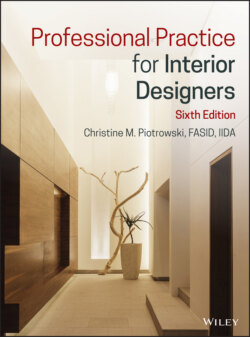Читать книгу Professional Practice for Interior Designers - Christine M. Piotrowski - Страница 168
PROFESSIONAL CONDUCT
ОглавлениеSamantha goes to the home of a new client. The client shows her boards and plans that obviously were not prepared by the client, although no designer name is on the boards. Samantha would really like to do this project, because the client is a well‐known celebrity and her company needs the business.
If you were the interior designer who had originally prepared the drawings and boards given to Samantha, what would you want her to do? What would you want her to say to the client?
It is argued that we learn our values and morals as we grow up and that our ethics spring from those years of learning. Value systems and moral conduct as a professional should, then, be ingrained from what we have learned from parents, relatives, teachers, clergy, and friends. As professionals, how we conduct our business relationships with clients, colleagues, and cohorts can have a positive or negative impact on everyone in the profession.
A professional is expected to provide competent services in a manner considered customary by those in the profession as well as those who utilize those professional services. Professional conduct also means that those entering the profession must abide by standards accepted by others in the profession.
A starting point for that professional conduct lies within the associations. Regardless of the type of business, professional associations expect their members to behave and conduct business in a manner that reflects positively upon all the members—and even nonmembers—of the association. Remember that when a designer at any level signs the application for membership in a professional association, the applicant is agreeing to abide by the association's code of ethics.
Choosing not to belong to an association, however, does not mean that someone in a profession can ignore ethics. Licensing and registration legislation almost invariably includes some reference to ethical behavior or discussion of disciplinary procedures for nonprofessional behavior.
The codes of ethics of the professional associations deal with enforceable ethical standards of practice and provide philosophical comments concerning the professional conduct of members. This discussion of codes of conduct uses that of IIDA (see Figure 7‐1). The reader can review the ASID Code of Ethics and Professional Conduct by searching the Web at www.asid.org/about. Readers can easily research codes of ethics or conduct from other associations or jurisdictional licensing boards by searching the Internet under the name of the organization.
These codes of ethics relate ethical issues between the designer/member and others in the profession. As you can see in the example, there are specific sections related to the designer' responsibility to the public, the client, other designers and colleagues, the association, and the profession.
These rules of conduct exist for members of an organization. They have no actual impact on interior designers who are not members of any professional organization. They can serve, however, as a guide to nonaffiliated interior designers and those in the design–build industry. An ethical charge cannot be brought against an unaffiliated designer, although a wronged party could file civil suits or other charges with the appropriate boards within a jurisdiction. For example, a client might file a grievance with the local registrar of contractors.
FIGURE 7‐1. IIDA Code of Ethics for Professional and Associate Member Conduct. This version is applicable to interior design practitioners only.
(Reprinted with permission of International Interior Design Association, Chicago, IL.)
Professional conduct and professional responsibility are interwoven in the overall practice of interior design. Designers do not necessarily give conscious thought to whether a daily activity that is part of working on a project for a client is done ethically or in a manner prescribed by the profession. Sometimes, though, a designer comes to an ethical crossroads and chooses to behave in a manner that contradicts a code of ethics or even the person's personal moral compass. When this happens, it hurts the individual, to be sure—tomorrow if not today—and it hurts everyone else and the profession in general.
